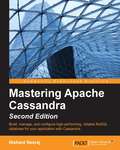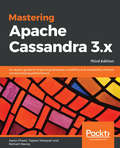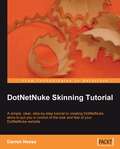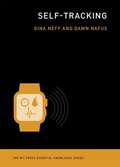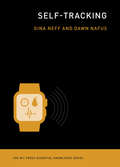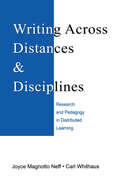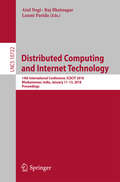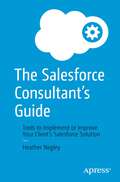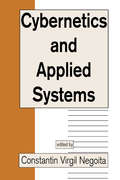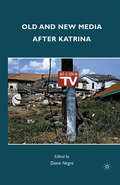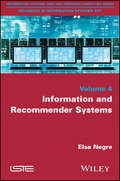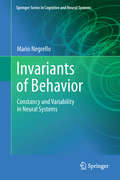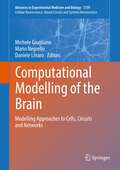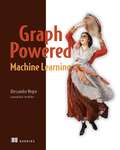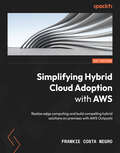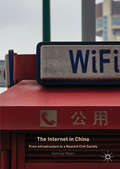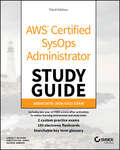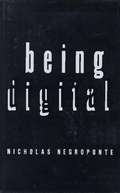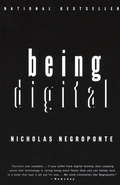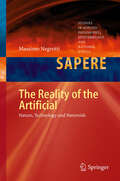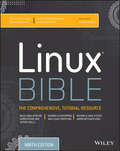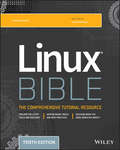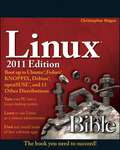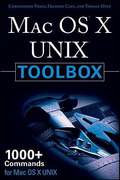- Table View
- List View
Mastering Apache Cassandra Second Edition
by Nishant Neeraj<P><P>Build, manage, and configure high-performing, reliable NoSQL database for your application with Cassandra <P><P>About This Book <P><P>Develop applications for modelling data with Cassandra 2 <P><P>Manage large amounts of structured, semi-structured, and unstructured data with Cassandra <P><P>Explore a wide-range of Cassandra components and how they interact to create a robust, distributed system. <P><P>Who This Book Is For <P><P>The book is aimed at intermediate developers with an understanding of core database concepts who want to become a master at implementing Cassandra for their application. <P><P>What You Will Learn <P><P>Write programs using Cassandra's features more efficiently <P><P>Get the most out of a given infrastructure, improve performance, and tweak JVM <P><P>Use CQL3 in your application, which makes working with Cassandra more simple <P><P>Configure Cassandra and fine-tune its parameters depending on your needs <P><P>Set up a cluster and learn how to scale it <P><P>Monitor Cassandra cluster in different ways <P><P>Use Hadoop and other big data processing tools with Cassandra <P><P>In Detail <P><P>With ever increasing rates of data creation comes the demand to store data as fast and reliably as possible, a demand met by modern databases such as Cassandra. Apache Cassandra is the perfect choice for building fault tolerant and scalable databases. Through this practical guide, you will program pragmatically and understand completely the power of Cassandra. Starting with a brief recap of the basics to get everyone up and running, you will move on to deploy and monitor a production setup, dive under the hood, and optimize and integrate it with other software. <P><P>You will explore the integration and interaction of Cassandra components, and explore great new features such as CQL3, vnodes, lightweight transactions, and triggers. Finally, by learning Hadoop and Pig, you will be able to analyze your big data.
Mastering Apache Cassandra 3.x: An expert guide to improving database scalability and availability without compromising performance, 3rd Edition
by Nishant Neeraj Aaron Ploetz Tejaswi MalepatiBuild, manage, and configure high-performing, reliable NoSQL database for your applications with CassandraKey FeaturesWrite programs more efficiently using Cassandra's features with the help of examplesConfigure Cassandra and fine-tune its parameters depending on your needsIntegrate Cassandra database with Apache Spark and build strong data analytics pipelineBook DescriptionWith ever-increasing rates of data creation, the demand for storing data fast and reliably becomes a need. Apache Cassandra is the perfect choice for building fault-tolerant and scalable databases. Mastering Apache Cassandra 3.x teaches you how to build and architect your clusters, configure and work with your nodes, and program in a high-throughput environment, helping you understand the power of Cassandra as per the new features.Once you’ve covered a brief recap of the basics, you’ll move on to deploying and monitoring a production setup and optimizing and integrating it with other software. You’ll work with the advanced features of CQL and the new storage engine in order to understand how they function on the server-side. You’ll explore the integration and interaction of Cassandra components, followed by discovering features such as token allocation algorithm, CQL3, vnodes, lightweight transactions, and data modelling in detail. Last but not least you will get to grips with Apache Spark.By the end of this book, you’ll be able to analyse big data, and build and manage high-performance databases for your application.What you will learnWrite programs more efficiently using Cassandra's features more efficientlyExploit the given infrastructure, improve performance, and tweak the Java Virtual Machine (JVM)Use CQL3 in your application in order to simplify working with CassandraConfigure Cassandra and fine-tune its parameters depending on your needsSet up a cluster and learn how to scale itMonitor a Cassandra cluster in different waysUse Apache Spark and other big data processing toolsWho this book is forMastering Apache Cassandra 3.x is for you if you are a big data administrator, database administrator, architect, or developer who wants to build a high-performing, scalable, and fault-tolerant database. Prior knowledge of core concepts of databases is required.
DotNetNuke Skinning Tutorial
by Darren NeeseDesigned as a tutorial for beginners to DotNetNuke skinning, this book is packed with practical steps for you to try. Written in a clear, easy-to-read style this book will guide you through the most important tasks of working with DotNetNuke skins. This book is for web designers or developers who want to customize DNN sites, to bring a specific look and feel to them, and create more attractive user interfaces. This book is ideal for beginners to DotNetNuke skinning. You will need to know about the general operation of DotNetNuke and also have some familiarity with creating web pages. Familiarity with CSS and basic ASP.NET would be a bonus.
Online Anti-Semitism in Turkey (Palgrave Pivot)
by Türkay Salim Nefeshis is the first study that examines online anti-Semitism in Turkey. Nefes surveys important historical events concerning Turkish-Jewry and analyses people's online expressions about Adolf Hitler in the most popular forum website in Turkey,
The Self-Tracking
by Gina Neff Dawn NafusPeople keep track. In the eighteenth century, Benjamin Franklin kept charts of time spent and virtues lived up to. Today, people use technology to self-track: hours slept, steps taken, calories consumed, medications administered. Ninety million wearable sensors were shipped in 2014 to help us gather data about our lives. This book examines how people record, analyze, and reflect on this data, looking at the tools they use and the communities they become part of. Gina Neff and Dawn Nafus describe what happens when people turn their everyday experience -- in particular, health and wellness-related experience -- into data, and offer an introduction to the essential ideas and key challenges of using these technologies. They consider self-tracking as a social and cultural phenomenon, describing not only the use of data as a kind of mirror of the self but also how this enables people to connect to, and learn from, others.Neff and Nafus consider what's at stake: who wants our data and why; the practices of serious self-tracking enthusiasts; the design of commercial self-tracking technology; and how self-tracking can fill gaps in the healthcare system. Today, no one can lead an entirely untracked life. Neff and Nafus show us how to use data in a way that empowers and educates.
Self-Tracking: The Mit Press Essential Knowledge Series (The MIT Press Essential Knowledge series)
by Gina Neff Dawn NafusWhat happens when people turn their everyday experience into data: an introduction to the essential ideas and key challenges of self-tracking.People keep track. In the eighteenth century, Benjamin Franklin kept charts of time spent and virtues lived up to. Today, people use technology to self-track: hours slept, steps taken, calories consumed, medications administered. Ninety million wearable sensors were shipped in 2014 to help us gather data about our lives. This book examines how people record, analyze, and reflect on this data, looking at the tools they use and the communities they become part of. Gina Neff and Dawn Nafus describe what happens when people turn their everyday experience—in particular, health and wellness-related experience—into data, and offer an introduction to the essential ideas and key challenges of using these technologies. They consider self-tracking as a social and cultural phenomenon, describing not only the use of data as a kind of mirror of the self but also how this enables people to connect to, and learn from, others.Neff and Nafus consider what's at stake: who wants our data and why; the practices of serious self-tracking enthusiasts; the design of commercial self-tracking technology; and how self-tracking can fill gaps in the healthcare system. Today, no one can lead an entirely untracked life. Neff and Nafus show us how to use data in a way that empowers and educates.
Writing Across Distances and Disciplines: Research and Pedagogy in Distributed Learning
by Joyce Magnotto Neff Carl WhithausWriting Across Distances and Disciplines addresses questions that cross borders between onsite, hybrid, and distributed learning environments, between higher education and the workplace, and between distance education and composition pedagogy. This groundbreaking volume raises critical issues, clarifies key terms, reviews history and theory, analyzes current research, reconsiders pedagogy, explores specific applications of WAC and WID in distributed environments, and considers what business and education might teach one another about writing and learning. Exploring the intersection of writing across the curriculum, composition studies, and distance learning , it provides an in-depth look at issues of importance to students, faculty, and administrators regarding the technological future of writing and learning in higher education.
Distributed Computing and Internet Technology
by Atul Negi Raj Bhatnagar Laxmi ParidaThis book constitutes the proceedings of the 13th International Conference on Distributed Computing and Internet Technology, ICDCIT 2017, held in Bhubaneswar, India, in January 2017. The 17 full papers and 3 poster papers presented together with 6 abstracts of invited talks were carefully reviewed and selected from 208 submissions (118 abstract and 90 full paper submissions). The ICDCIT conference focusses on mobile computing; analytics; distributed computing; virtual machines; access control; and security and privacy.
The Salesforce Consultant’s Guide: Tools to Implement or Improve Your Client’s Salesforce Solution
by Heather NegleyBreak down the art and science of Salesforce consulting. This book will help you refine your consulting skills on the Salesforce platform. Author Heather Negley, a seasoned consultant who has completed over 30 Salesforce delivery projects in the past nine years, equips Salesforce professionals with detailed explanations on the stages of a project and the skills you need for each stage. You will learn the type of roles on a project, so that you can plan your career path.If you need help managing clients, this book teaches you how to effectively work with and advise people. You will go through the following main sections to round out your skills and service offerings:The best learning and community resources, including mentoring programsTips on how to get job experienceThe evolution of software developmentProject rolesThe parts of a projectConsulting skills The consulting skills section of the book breaks down each skill and explains the parts of the project to which you should apply your skills and real-world examples. Topics include client management, communication, emotional intelligence, critical thinking, and avoiding cognitive biases.What You Will Learn Identify patterns in your projects through archetype identificationWatch out for specific risks common to project typesChoose the best consulting tool from your toolbox, depending on the problem that you encounterWho This Book Is ForPeople who work as Salesforce administrators for their industry and want to make a move into consulting. It is an excellent choice for someone who is interested in project work and likes to work with people to help them make decisions.
Cybernetics and Applied Systems
by Constantin Virgil NegoitaIn light of the enormous interest in building intelligent systems, this volume blends theory, applications, and methodology of cybernetics taking it out of the realm of the abstract and explaining how cybernetics can contribute to an improved understanding of intelligence. Among the topics of the 17
Old and New Media after Katrina
by Diane NegraOn the fifth anniversary of Hurricane Katrina, this book examines the television coverage of September, 2005, and the manifestation of its legacy in a range of other media forms.
Information and Recommender Systems
by Elsa NegreInformation is an element of knowledge that can be stored, processed or transmitted. It is linked to concepts of communication, data, knowledge or representation. In a context of steady increase in the mass of information it is difficult to know what information to look for and where to find them. Computer techniques exist to facilitate this research and allow relevant information extraction. Recommendation systems introduced the notions inherent to the recommendation, based, inter alia, information search, filtering, machine learning, collaborative approaches. It also deals with the assessment of such systems and has various applications.
Invariants of Behavior
by Mario NegrelloThe study of the brain and behavior is illuminated with the discovery of invariances. Experimental brain research uncovers constancies amidst variation, with respect to interventions and transformations prescribed by experimental paradigms. Place cells, mirror neurons, event related potentials and areas differentially active in fMRI, all illustrate the pervasive role of invariances in neural systems in relation to their function.
Computational Modelling of the Brain: Modelling Approaches to Cells, Circuits and Networks (Advances in Experimental Medicine and Biology #1359)
by Mario Negrello Michele Giugliano Daniele LinaroThis volume offers an up-to-date overview of essential concepts and modern approaches to computational modelling, including the use of experimental techniques related to or directly inspired by them. The book introduces, at increasing levels of complexity and with the non-specialist in mind, state-of-the-art topics ranging from single-cell and molecular descriptions to circuits and networks.Four major themes are covered, including subcellular modelling of ion channels and signalling pathways at the molecular level, single-cell modelling at different levels of spatial complexity, network modelling from local microcircuits to large-scale simulations of entire brain areas and practical examples. Each chapter presents a systematic overview of a specific topic and provides the reader with the fundamental tools needed to understand the computational modelling of neural dynamics. This book is aimed at experimenters and graduate students with little or no prior knowledge of modelling who are interested in learning about computational models from the single molecule to the inter-areal communication of brain structures. The book will appeal to computational neuroscientists, engineers, physicists and mathematicians interested in contributing to the field of neuroscience.Chapters 6, 10 and 11 are available open access under a Creative Commons Attribution 4.0 International License via link.springer.com.
Graph-Powered Machine Learning
by Alessandro NegroUpgrade your machine learning models with graph-based algorithms, the perfect structure for complex and interlinked data.Summary In Graph-Powered Machine Learning, you will learn: The lifecycle of a machine learning project Graphs in big data platforms Data source modeling using graphs Graph-based natural language processing, recommendations, and fraud detection techniques Graph algorithms Working with Neo4J Graph-Powered Machine Learning teaches to use graph-based algorithms and data organization strategies to develop superior machine learning applications. You&’ll dive into the role of graphs in machine learning and big data platforms, and take an in-depth look at data source modeling, algorithm design, recommendations, and fraud detection. Explore end-to-end projects that illustrate architectures and help you optimize with best design practices. Author Alessandro Negro&’s extensive experience shines through in every chapter, as you learn from examples and concrete scenarios based on his work with real clients! Purchase of the print book includes a free eBook in PDF, Kindle, and ePub formats from Manning Publications. About the technology Identifying relationships is the foundation of machine learning. By recognizing and analyzing the connections in your data, graph-centric algorithms like K-nearest neighbor or PageRank radically improve the effectiveness of ML applications. Graph-based machine learning techniques offer a powerful new perspective for machine learning in social networking, fraud detection, natural language processing, and recommendation systems. About the book Graph-Powered Machine Learning teaches you how to exploit the natural relationships in structured and unstructured datasets using graph-oriented machine learning algorithms and tools. In this authoritative book, you&’ll master the architectures and design practices of graphs, and avoid common pitfalls. Author Alessandro Negro explores examples from real-world applications that connect GraphML concepts to real world tasks. What's inside Graphs in big data platforms Recommendations, natural language processing, fraud detection Graph algorithms Working with the Neo4J graph database About the reader For readers comfortable with machine learning basics. About the author Alessandro Negro is Chief Scientist at GraphAware. He has been a speaker at many conferences, and holds a PhD in Computer Science. Table of Contents PART 1 INTRODUCTION 1 Machine learning and graphs: An introduction 2 Graph data engineering 3 Graphs in machine learning applications PART 2 RECOMMENDATIONS 4 Content-based recommendations 5 Collaborative filtering 6 Session-based recommendations 7 Context-aware and hybrid recommendations PART 3 FIGHTING FRAUD 8 Basic approaches to graph-powered fraud detection 9 Proximity-based algorithms 10 Social network analysis against fraud PART 4 TAMING TEXT WITH GRAPHS 11 Graph-based natural language processing 12 Knowledge graphs
Simplifying Hybrid Cloud Adoption with AWS: Realize edge computing and build compelling hybrid solutions on premises with AWS Outposts
by Frankie Costa NegroBecome an expert in AWS Outposts and Hybrid architectures with in-depth explanations of the product and order processes while exploring the capabilities for creating next-generation edge solutionsKey FeaturesLearn AWS Outposts from the ground up guided by an AWS hybrid edge solutions architectMaster hybrid edge concepts, use cases, and architectures and discover how AWS Outposts fits into this spaceBecome the go-to professional for designing, deploying, operating, and maintaining AWS OutpostsBook DescriptionThe hybrid edge specialty is often misunderstood because it began with an on-premises-focused view encompassing everything not running inside the traditional data center. If you too have workloads that need to live on premises and need a solution to bridge the gap between both worlds, this book will show you how AWS Outposts allows workloads to leverage the benefits of the cloud running on top of AWS technology. In this book, you'll learn what the Edge space is, the capabilities to look for when selecting a solution to operate in this realm, and how AWS Outposts delivers. The use cases for Outposts are thoroughly explained and the physical characteristics are detailed alongside the service logical constructs and facility requirements. You'll gain a comprehensive understanding of the sales process—from order placement to rack delivery to your location. As you advance, you'll explore how AWS Outposts works in real life with step-by-step examples using AWS CLI and AWS Console before concluding your journey with an extensive overview of security and business continuity for maximizing the value delivered by the product. By the end of this book, you'll be able to create compelling hybrid architectures, solve complex use cases for hybrid scenarios, and get ready for your way forward with the help of expert guidance.What you will learnDiscover the role of AWS Outposts in the hybrid edge spaceUnderstand rack components with typical use cases for AWS OutpostsExplore AWS services running on Outposts and its capabilitiesSelect, order, and successfully deploy your OutpostsWork with Outposts resources for hands-on operationsAssess logical and physical security aspects and considerationsMonitor and log configuration and usage to improve your architectureMaintain and troubleshoot hardware and software that run AWS servicesWho this book is forIf you are a seasoned data center professional, this book will empower you to support businesses to build hybrid edge solutions with AWS technology. It will also help AWS Cloud professionals to master a unique offering in the AWS portfolio that takes Amazon web services beyond the regions. Familiarity with AWS services and traditional data center concepts is assumed.
The Internet in China
by Gianluigi NegroThis book aims to identify the most important political, socio-economic, and technical determinants of Internet development in China, through a historical approach that combines political economy, cultural, and public studies. Firstly, the book looks at the most important strategies that compelled the Chinese government to invest in the construction of the Internet infrastructure. Secondly, it examines the relationships between the development of the Internet in China and the emergence of a nascent civil society. Finally, attention is given to three different Chinese online platforms in three different historical periods. This three-pronged approach presents a coherent set of analyses and case studies which are committed to the investigation of the complex process of change undergone by Internet development in China.
AWS Certified SysOps Administrator Study Guide: Associate SOA-C02 Exam (Sybex Study Guide)
by Jorge T. Negron Christoffer Jones George SawyerPrepare for success on the AWS SysOps exam, your next job interview, and in the field with this handy and practical guide The newly updated Third Edition of AWS Certified SysOps Administrator Study Guide: Associate (SOA-C02) Exam prepares you for the Amazon Web Services SysOps Administrator certification and a career in the deployment, management, and operation of an AWS environment. Whether you’re preparing for your first attempt at the challenging SOA-C02 Exam, or you want to upgrade your AWS SysOps skills, this practical Study Guide delivers the hands-on skills and best practices instruction you need to succeed on the test and in the field. You’ll get: Coverage of all of the SOA-C02 exam’s domains, including monitoring, logging, remediation, reliability, business continuity, and more Instruction that’s tailor-made to achieve success on the certification exam, in an AWS SysOps job interview, and in your next role as a SysOps administrator Access to the Sybex online study tools, with chapter review questions, full-length practice exams, hundreds of electronic flashcards, and a glossary of key terms The AWS Certified SysOps Administrator Study Guide: Associate (SOA-C02) Exam includes all the digital and offline tools you need to supercharge your career as an AWS Certified SysOps Administrator.
Being Digital
by Nicholas NegroponteA Professor of MIT and former director of its Media lab expounds on his philosophy and opinions of the digital world.
Being Digital
by Nicholas NegroponteIn lively, mordantly witty prose, Negroponte decodes the mysteries--and debunks the hype--surrounding bandwidth, multimedia, virtual reality, and the Internet, and explains why such touted innovations as the fax and the CD-ROM are likely to go the way of the BetaMax. "Succinct and readable. . . . If you suffer from digital anxiety . . . here is a book that lays it all out for you."--Newsday.
The Reality of the Artificial
by Massimo NegrottiThe human ambition to reproduce and improve natural objects and processes has a long history, and ranges from dreams to actual design, from Icarus's wings to modern robotics and bioengineering. This imperative seems to be linked not only to practical utility but also to our deepest psychology. Nevertheless, reproducing something natural is not an easy enterprise, and the actual replication of a natural object or process by means of some technology is impossible. In this book the author uses the term naturoid to designate any real artifact arising from our attempts to reproduce natural instances. He concentrates on activities that involve the reproduction of something existing in nature, and whose reproduction, through construction strategies which differ from natural ones, we consider to be useful, appealing or interesting. The development of naturoids may be viewed as a distinct class of technological activity, and the concept should be useful for methodological research into establishing the common rules, potentialities and constraints that characterize the human effort to reproduce natural objects. The author shows that a naturoid is always the result of a reduction of the complexity of natural objects, due to an unavoidable multiple selection strategy. Nevertheless, the reproduction process implies that naturoids take on their own new complexity, resulting in a transfiguration of the natural exemplars and their performances, and leading to a true innovation explosion. While the core performances of contemporary naturoids improve, paradoxically the more a naturoid develops the further it moves away from its natural counterpart. Therefore, naturoids will more and more affect our relationships with advanced technologies and with nature, but in ways quite beyond our predictive capabilities. The book will be of interest to design scholars and researchers of technology, cultural studies, anthropology and the sociology of science and technology.
Linux Bible: Boot Up Ubuntu, Fedora, Knoppix, Debian, Suse, And 11 Other Distributions (Bible #772)
by Christopher NegusThe industry favorite Linux guide, updated for Red Hat Enterprise Linux 7 and the cloud Linux Bible, 9th Edition is the ultimate hands-on Linux user guide, whether you're a true beginner or a more advanced user navigating recent changes. This updated ninth edition covers the latest versions of Red Hat Enterprise Linux 7 (RHEL 7), Fedora 21, and Ubuntu 10.04 LTS, and includes new information on cloud computing and development with guidance on Openstack and Cloudforms. With a focus on RHEL 7, this practical guide gets you up to speed quickly on the new enhancements for enterprise-quality file systems, the new boot process and services management, firewalld, and the GNOME 3 desktop. Written by a Red Hat expert, this book provides the clear explanations and step-by-step instructions that demystify Linux and bring the new features seamlessly into your workflow. This useful guide assumes a base of little or no Linux knowledge, and takes you step by step through what you need to know to get the job done. Get Linux up and running quickly Master basic operations and tackle more advanced tasks Get up to date on the recent changes to Linux server system management Bring Linux to the cloud using Openstack and Cloudforms Linux Bible, 9th Edition is the one resource you need, and provides the hands-on training that gets you on track in a flash.
Linux Bible: Boot Up Ubuntu, Fedora, Knoppix, Debian, Suse, And 11 Other Distributions (Bible #490)
by Christopher NegusThe industry favorite Linux guide Linux Bible, 10th Edition is the ultimate hands-on Linux user guide, whether you're a true beginner or a more advanced user navigating recent changes. this updated tenth edition covers the latest versions of Red Hat Enterprise Linux (RHEL 8), Fedora 30, and Ubuntu 18.04 LTS. It includes information on cloud computing, with new guidance on containerization, Ansible automation, and Kubernetes and OpenShift. With a focus on RHEL 8, this new edition teaches techniques for managing storage, users, and security, while emphasizing simplified administrative techniques with Cockpit. Written by a Red Hat expert, this book provides the clear explanations and step-by-step instructions that demystify Linux and bring the new features seamlessly into your workflow. This useful guide assumes a base of little or no Linux knowledge, and takes you step by step through what you need to know to get the job done. Get Linux up and running quickly Master basic operations and tackle more advanced tasks Get up to date on the recent changes to Linux server system management Bring Linux to the cloud using Openstack and Cloudforms Simplified Linux administration through the Cockpit Web Interface Automated Linux Deployment with Ansible Learn to navigate Linux with Amazon (AWS), Google (GCE), and Microsofr Azure Cloud services Linux Bible, 10th Edition is the one resource you need, and provides the hands-on training that gets you on track in a flash.
Linux Bible 2010 Edition
by Christopher NegusThe definitive guide to the basics of one of the most popular operating systems in the worldWhether you're a first-time Linux user or you're migrating from another operating system, this book is an ideal introductory guide for getting comfortable with the building-block nature of Linux. Written by bestselling author Christopher Negus, this guide is packed with in-depth descriptions on the basics of Linux desktops, servers, and programming tools and gets you up to speed on all the new and exciting features of the newest version: Linux 2010. Negus walks you through transitioning from Windows or Mac and helps you find the Linux distribution that best meets your needs.You'll explore more than 18 Linux distributions, including the latest versions of Ubuntu, Fedora, Debian, OpenSUSE, Slackware, Knoppix, Gentoo, Mandriva, SLAX, and more. Plus, you'll discover how to set up secure, fully functioning Linux server systems and get up-to-date installation advice.Topics Covered:Getting off the Ground with LinuxRunning a Linux DesktopLearning System Administration SkillsSetting Up Linux ServersChoosing and Installing Different Linux DistributionsProgramming in LinuxLinux Bible 2010 Edition walks you through the details of the various Linux distributions and updates you on the latest networking, desktop, and server enhancements.Note: CD-ROM/DVD and other supplementary materials are not included as part of eBook file.
MAC OS X UNIX Toolbox
by Christopher NegusExplore a ton of powerful Mac OS X UNIX commands This handy, compact guide teaches you to use Mac OS X UNIX systems as the experts do: from the command line. Try out more than 1,000 commands to find and get software, monitor system health and security, and access network resources. Apply the skills you learn from this book to troubleshoot networks, lock down security, and uncover almost anything you care to know about your Mac OS X system. Expand your Mac OS X UNIX expertise in these and other areas: Using the shell Finding online software Working with files Playing with music and images Administering file systems Backing up data Checking and managing running processes Accessing network resources Handling remote system administration Locking down security
